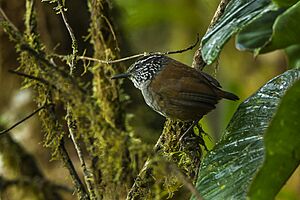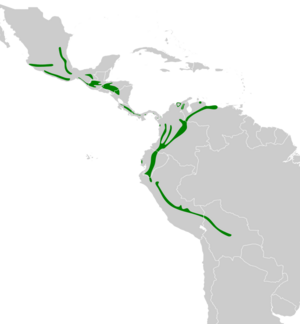Grey-breasted wood wren facts for kids
Quick facts for kids Grey-breasted wood wren |
|
|---|---|
 |
|
| Conservation status | |
| Scientific classification | |
| Genus: |
Henicorhina
|
| Species: |
leucophrys
|
 |
|
The grey-breasted wood wren (Henicorhina leucophrys) is a small, active bird. It belongs to the wren family. You can find this bird from Mexico all the way down to Bolivia. It often lives in mountain forests.
Contents
About the Grey-breasted Wood Wren
Scientists are still studying the grey-breasted wood wren. They are trying to figure out how many different types, or subspecies, of this bird exist. Some groups of scientists recognize about 13 to 17 subspecies. Other research suggests there might be as many as 35 distinct groups. This shows that nature is full of amazing variety!
What Does It Look Like?
The grey-breasted wood wren is a small bird. It is about 10 to 11.5 centimeters (4 to 4.5 inches) long. It weighs around 13.5 to 17.7 grams (about half an ounce).
Its head has dull black feathers with dark brown tips. Its neck and shoulders are a dark olive-brown color. The lower back and tail are chestnut brown. The tail also has thin black stripes.
This bird has a long, light gray stripe above its eye. This stripe is called a supercilium. It also has a wide black stripe behind its eye. Its cheeks are black with pale gray streaks. The chin and throat are pale gray. The chest and belly are a darker gray. The sides of its belly are a dark buff color. Different types of grey-breasted wood wrens can look slightly different. They might vary in size or the brightness of their colors.
Where Does It Live?
The grey-breasted wood wren lives in many places. Its home range stretches from Mexico through Central America. In South America, it lives in Venezuela and south to central Bolivia.
This bird prefers humid mountain forests. It can be found in many types of these forests. Usually, it lives at high elevations, above 1,500 meters (about 4,900 feet). However, in some areas like Colombia, it can be seen as low as 400 meters (about 1,300 feet). In Venezuela and Colombia, it can live as high as 3,000 meters (about 9,800 feet).
How Does It Behave?
Feeding Habits
The grey-breasted wood wren looks for food alone or in small groups. It usually searches for food close to the ground. It stays within 2 meters (about 6.5 feet) of the ground in plants. This bird eats only small bugs and other tiny creatures without backbones. Sometimes, in places like Costa Rica, Colombia, and Venezuela, it follows army ant swarms. These ants stir up insects, making them easier for the wren to catch.
Reproduction and Life Cycle
The breeding season for the grey-breasted wood wren changes depending on where it lives. For example, in Mexico, they lay eggs from May to June. In Costa Rica, it's from March to June. In Ecuador, it can be from November to June.
The nest is shaped like a ball. It has a special entrance that points downwards. The birds build their nests using small rootlets and moss. They often place the nest in plants up to 3 meters (about 10 feet) above the ground. Nests are often found over a bank or a ravine. The female bird lays two eggs. She sits on the eggs to keep them warm. Both the male and female parents help feed the baby birds.
Vocalization
The songs and calls of the grey-breasted wood wren are quite varied. They sound different in different parts of its range. Generally, their songs are very loud and energetic. They are made of musical phrases that are often repeated. This bird sings almost all year round. It sings throughout the day, no matter the weather. People often hear this bird much more than they see it.
Conservation Status
The IUCN (International Union for Conservation of Nature) has looked at the grey-breasted wood wren. They have assessed it as a species of "Least Concern." This means the bird is not currently at risk of disappearing. It is common or even abundant in many of the places it lives.


